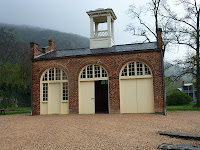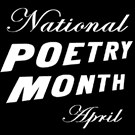First a bit about Antietam: After visiting Gettysburg in the rain last year, I'm beginning to think it's best to view a Civil War battlefield with the mist pillowing in the valleys and surrounding the cannons and soldier monuments, as if a ragged, ghostly band of fighters might suddenly appear in the penetrating dampness. "I love the smell of new, wet grass in the morning."
I know, bad parody of the Robert Duval line from Apocalypse Now. Here's that famous cut:
http://www.youtube.com/watch?v=bPXVGQnJm0w
These Civil War battles were absolutely amazing in terms of the carnage. Lines of soldiers would simply march across the rolling fields toward each other with guns and cannons blazing. Antietam was a one day battle with 17,000 killed and 6,000 wounded--the largest single day loss of life in the Civil War. Gettysburg claimed around 50,000 casualties, but that was over a three day period. The famous photographer Matthew Brady turned his portrait skills to scenes of battle dead, the first time that had ever been done. While newspapers could not yet publish photographs, they could publish woodcuts made from the photos and Brady's originals were displayed in his NYC gallery, bringing home the horrors of wartime. Sharpsburg, the town nearest the battle, was never quite the same, with the burden of caring for the wounded and the spread of disease transforming the farming community into an extended field hospital for many years. Clara Barton, the Angel of the Battlefield, nursed the wounded.
Strategically, Antietam was a lost opportunity for the North, since they won the battle, but reluctant General McClellan hesitated to chase after the decimated Army of Northern Virginia and historians claim the war could have ended then in 1862 with a decisive routing of Lee. Instead, McClellan allowed Lee to escape and regroup to fight another day and the war would drag on for another three years. For Lincoln, it was the Northern victory he had been waiting for in order to issue the Emancipation Proclamation, which initially applied only to rebel states. Lincoln visited the battlefield two weeks after the fighting ended, met with McClellan with whom he was extremely disappointed. One year later the scenario would replay with a timid General Meade also not pursuing Lee after Gettysburg.
Harper's Ferry, WV also played a role in the civil war, changing hands several times between the Union and the Confederates. It served as a major armory and arsenal for the US Army. The town is at the confluence of the Potomac and the Shenandoah Rivers, surrounded by wooded green mountains. Who owned the strategic high ground determined who ultimately would control the town, a lesson the Union learned early on.
But Harpers Ferry is best known for John Brown's raid in 1859, the fanatical abolitionist's call to arms for a slave rebellion. His 21 man party was able to capture the arsenal, but unable to hold it more than 36 hours. Here is the building where Brown made his last stand, later being called John Brown's Fort. Brown was captured, tried and hung within 2 months--swift justice in those days.
This famous picture shows him as the crusading biblical figure and captures the intensity and fanaticism of his movement. Some things you might not have known about him: He was married twice, had 20 children, 11 of whom died before adulthood, is buried in North Elba NY, the last farm where he lived. He and his sons had traveled to Bleeding Kansas in 1856, where the issue of free vs slave state had not been resolved, and participated in bloody, nighttime killing spree of those who believed Kansas should be a slave state. He escaped back to Ohio and NY, eventually planning his final disastrous rebellion that would become an emotional touchstone of the deep seated divisions between North and South that would lead to the Civil War.
If you've gotten this far in the reading, you know I love history, but let us not forget that April is National Poetry month. Not exactly high literature, but I will end with a famous poem (song) from the 1860's: John Brown's Song. It grew from the folk tradition, had popular versions as a Union marching song with the Glory, Glory, Hallelujah chorus and its melody became the Battle Hymn of the Republic written by Julia Howe in 1861.
Here is a version of the poem by William Weston Patton, written in 1861 and published in the Chicago Tribune. (If the meter seems a bit off to you, just sing the verses!)
- John Brown was a hero, undaunted, true and brave,
- And Kansas knows his valor when he fought her rights to save;
- Now, tho the grass grows green above his grave,
- His soul is marching on.
- He captured Harper’s Ferry, with his nineteen men so few,
- And frightened "Old Virginny" till she trembled thru and thru;
- They hung him for a traitor, they themselves the traitor crew,
- But his soul is marching on.
- John Brown was John the Baptist of the Christ we are to see,
- Christ who of the bondmen shall the Liberator be,
- And soon thruout the Sunny South the slaves shall all be free,
- For his soul is marching on.
- The conflict that he heralded he looks from heaven to view,
- On the army of the Union with its flag red, white and blue.
- And heaven shall ring with anthems o’er the deed they mean to do,
- For his soul is marching on.
- Ye soldiers of Freedom, then strike, while strike ye may,
- The death blow of oppression in a better time and way,
- For the dawn of old John Brown has brightened into day,
- And his soul is marching on







No comments:
Post a Comment